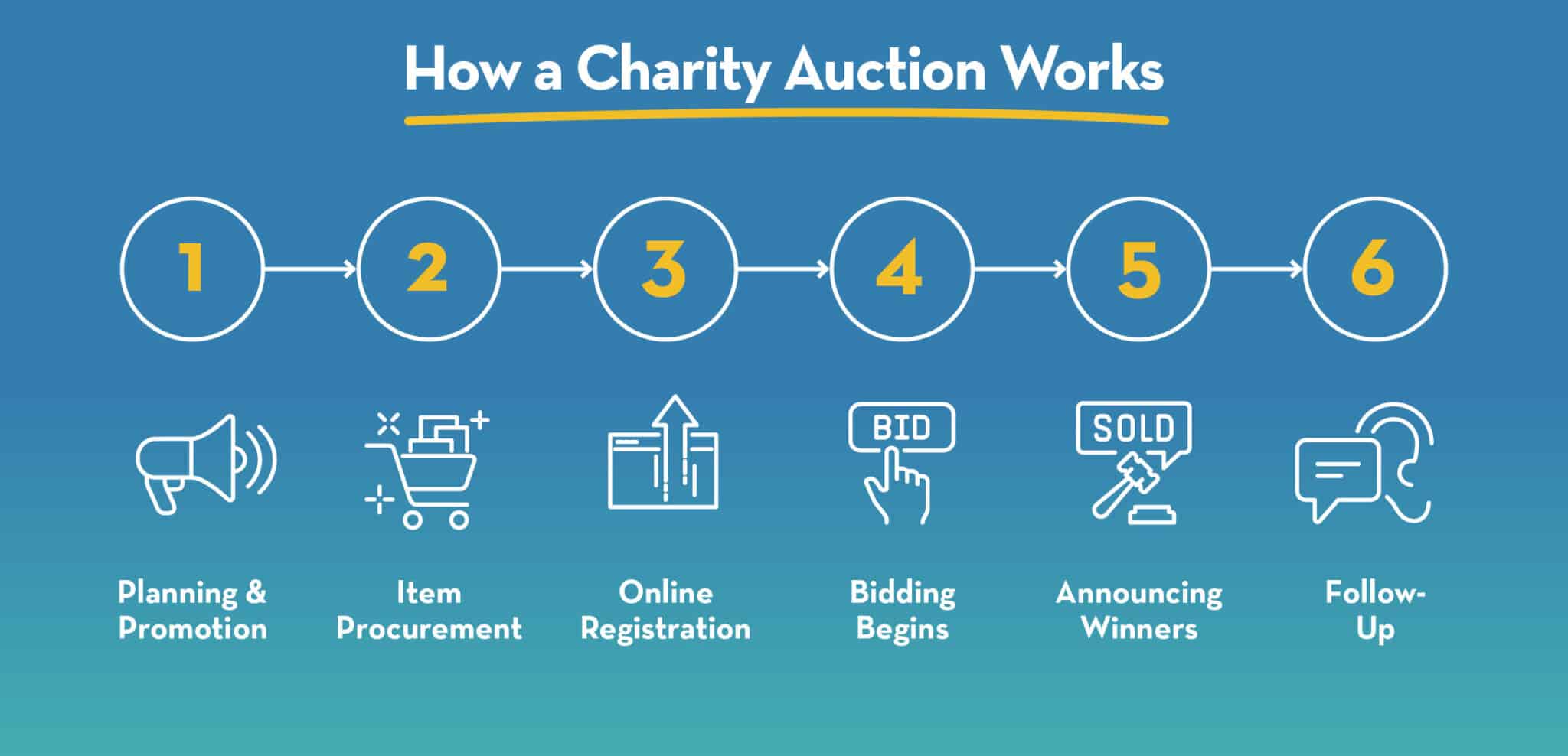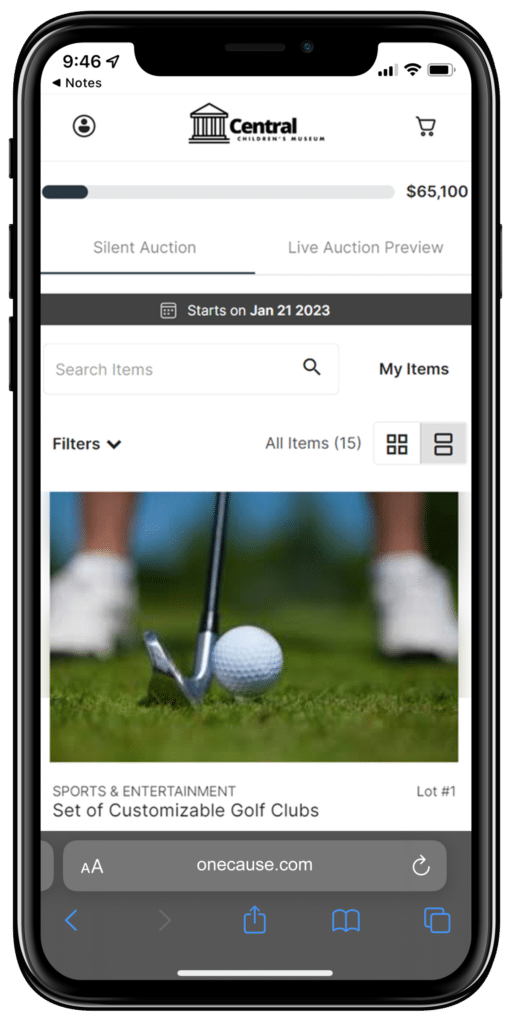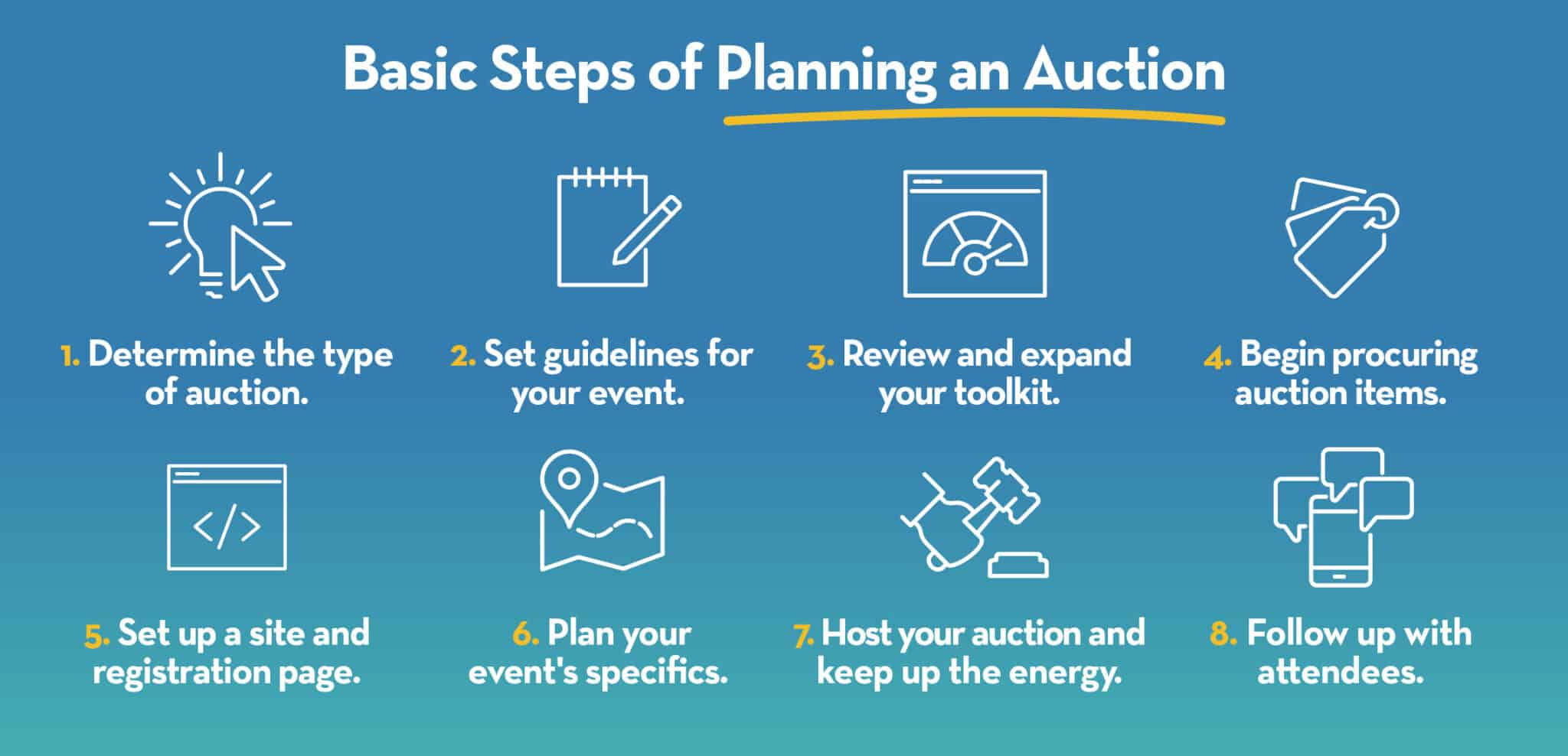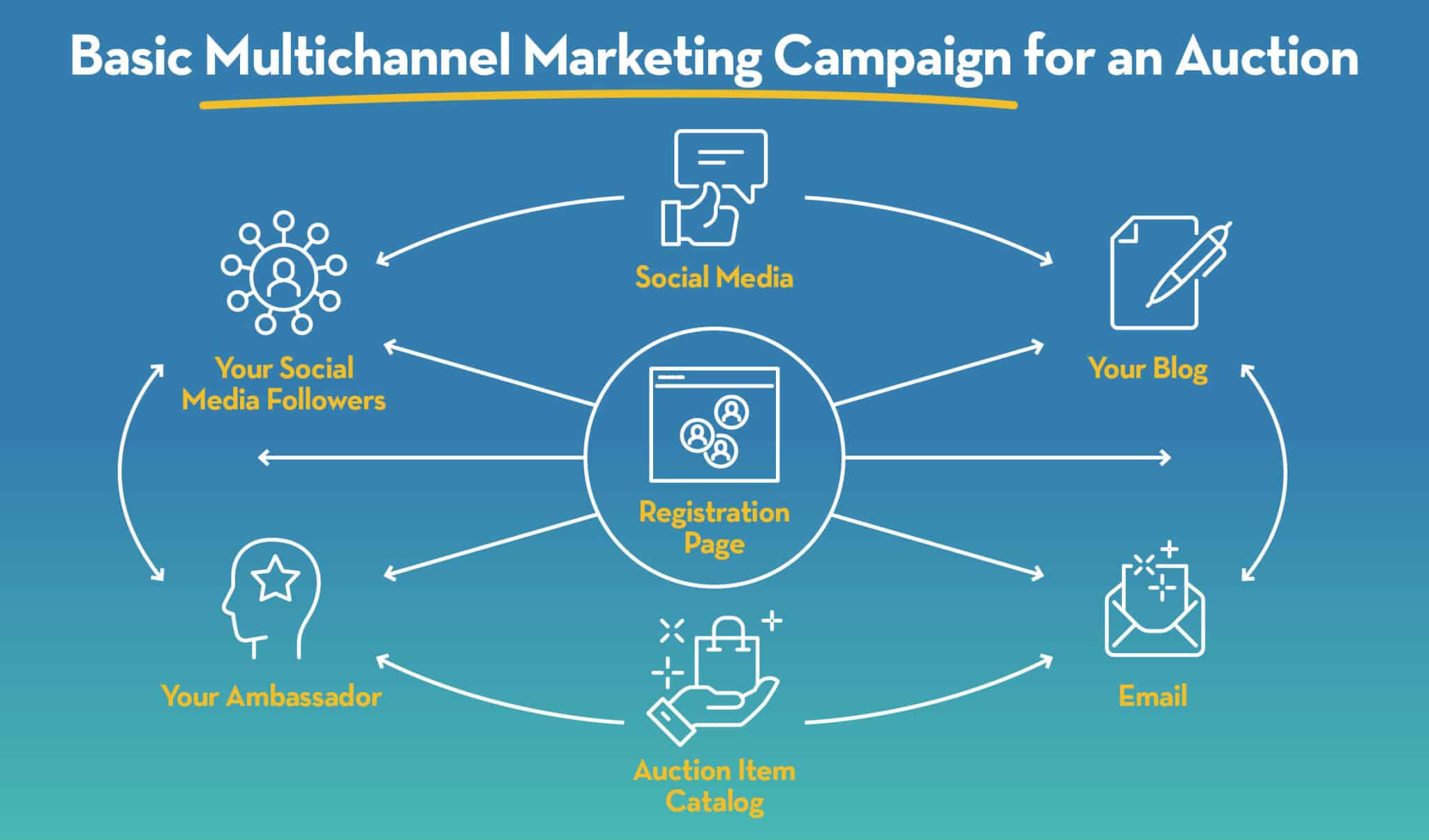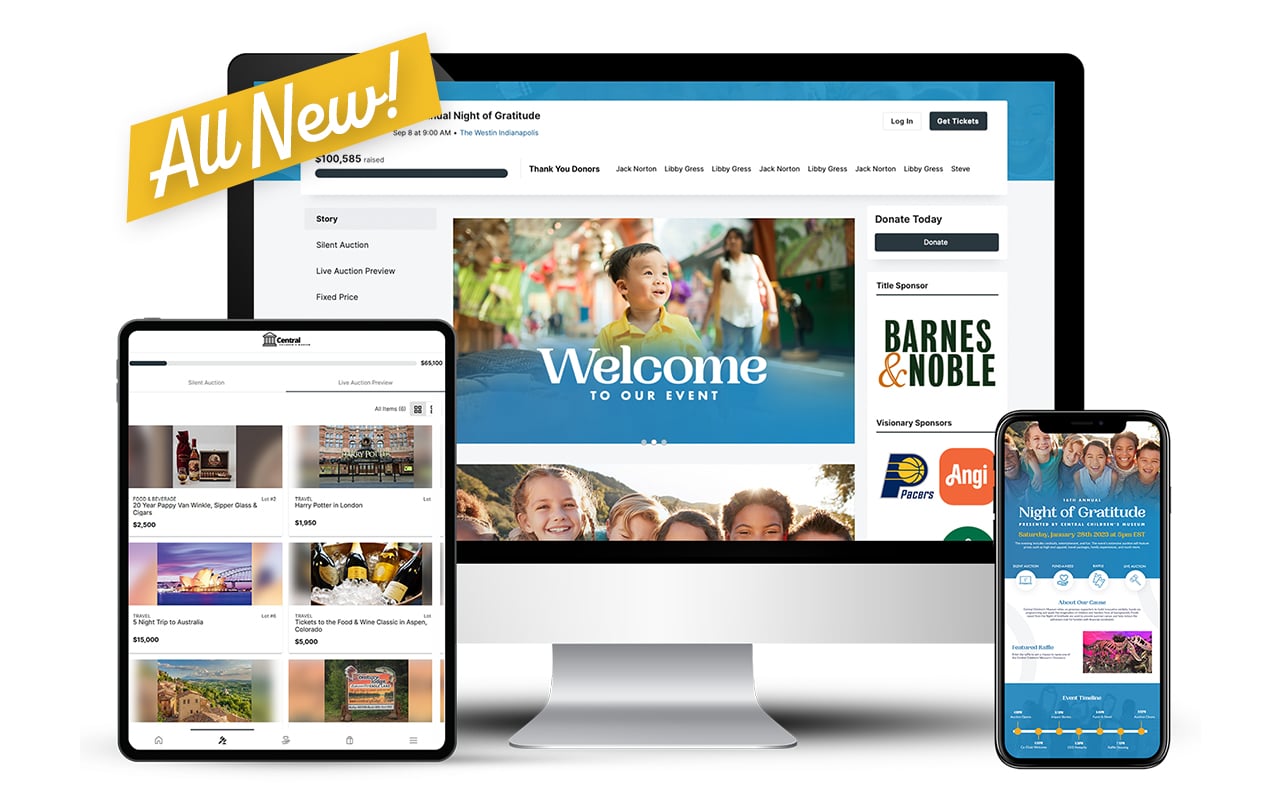Charity Auctions | The Complete Guide for Nonprofits
Charity auctions (whether live, silent, or online) are fundraising events in which guests bid to win auction items and packages. The highest bid wins the item, and the fundraising organization receives the proceeds. A win-win! These are highly engaging events that lay the groundwork for long-term engagement with donors.
If your organization is planning to host a charity auction, you’ve come to the right place.
At OneCause, we’ve helped hundreds of organizations raise more with auctions. In this guide, we’ll walk through all the essentials you’ll need to become an auction planning pro.
Charity Auctions 101: Covering the Essentials
Use the table above to navigate to a specific section, or follow along with us from the top. You’ll be rocking your next charity auction in no time!
Charity Auction FAQs
First, let’s cover a few frequently asked questions about these fundraising events:
Charity Auctions: Frequently Asked Questions
| Question | Answer |
|---|---|
| Who can host charity auctions? | All types of fundraising organizations host auctions - nonprofits, schools, universities, community groups, and more. Explore our success stories for real-life examples. |
| Can small nonprofits host auctions? | Yes, organizations of all sizes can succeed with charity auctions! These are flexible events that can be adapted for a variety of scales and audiences. |
| Can a charity auction be hosted virtually? | Yes! Online auctions are a cost-effective way to take your fundraising virtual. We'll cover more about these events below. |
| How do you find the right auction items? | We'll cover auction item procurement below, but we recommend starting with reviewing your donor data. What are their interests? How much can they afford to bid? |
| Are auction bids tax-deductible? | Yes, any amount paid over an item's fair market value can be deducted as a normal contribution. The IRS has specific guidance about charity auction deductions. |
Types of Charity Auctions
There are three types of auctions that your organization might host:
Online or Virtual Charity Auctions
An online or virtual auction is held exclusively online through a dedicated website and item catalog. Auction software helps organizations manage the entire process! Choosing the right solution makes the logistics of virtual fundraising much simpler than in-person auctions.
Success Story: Discover how Believe Ranch & Rescue used the OneCause Fundraising Platform to ignite Giving Tuesday generosity.
Live Charity Auctions
During these classic, high-energy events, an auctioneer will present auction items and manage the bidding process. Guests typically place bids by raising paddles or shouting, but mobile bidding tools can simplify and speed up the process. Live auctions are often more elaborate and hosted as part of a gala.
Success Story: Learn more about how New Life Academy streamlined their annual auction with OneCause.
Silent Charity Auctions
At a silent auction, you display items and packages on tables for guests to bid on by writing amounts on paper bid sheets or by using their smartphones via mobile bidding software. These events are very flexible and can be easily adapted for any audience and price range.
Success Story: Explore how Newhouse used the OneCause Fundraising Platform to boost their gala’s silent auction results.
Each of these types of auctions is highly adaptable to your particular needs and audience. You can even combine them!
For instance, a virtual auction can be paired with an engaging livestreamed live bidding portion. This is a great way to boost the energy and competition for your top items. The OneCause Fundraising Platform makes it easy! Take a tour today.
How Charity Auctions Work
The basic format of any type of charity auction is fairly straightforward:
- Your organization plans and promotes the event.
- Your procurement team gathers an exciting range of auction items.
- Supporters register online (ideally saving their payment information in advance).
- The auction begins and attendees start placing bids.
- Once time’s up, the highest bids win the items.
- Your team distributes items to winners and begins following up to thank attendees.
This core structure can then be adapted for each type of auction. A live auction involves presenting your items one-by-one, while silent and online auctions allow guests to browse all items and place bids at their own pace.
When choosing how exactly you’ll structure your charity auction, there are a few key pros and cons worth keeping in mind:
Online auctions are cost-effective and let you reach wide virtual audiences.
However, you’ll have to go the extra mile to reinforce your mission and keep the entire virtual event engaging for audiences. Livestreamed elements and peer-to-peer tactics can be helpful for this purpose.
Live auctions are classic, high-energy events that can raise a lot of money.
They can be difficult to plan, but they’re very effective when targeted to the right audience. Big price tags and a competitive atmosphere in a public setting might be overwhelming for many potential attendees, though.
Silent auctions are extremely flexible for practically any audience.
They’re easier to plan than live auctions but still require plenty of strategy. A more relaxed atmosphere can be the right move, but you’ll have to actively maintain the energy and momentum of the event to generate bids.
When you’ve settled on which type of charity auction will be best for your organization, your fundraising goals, and your audience, there are a few additional considerations to keep in mind.
- What will be the larger context or setting for your charity auction? You could host a standalone live or silent auction, or plan it as part of a larger gala or other event like a golf tournament. Virtual auctions and in-person events can also serve as the grand finale to an extended online campaign, like an ambassador fundraising campaign.
- What will be the charity auction’s timeframe? While silent and live auctions are one-time events, you still need plenty of time to plan and promote them. Online auctions typically occur over an extended period, anywhere from a few days to two weeks.
- How will attendees place their bids? Mobile bidding tools, online bids, paddle raises, or paper bid sheets? Think about this element early since it will impact how you handle other logistics, like creating bid sheets or investing in mobile bidding software.
The core charity auction format can be built out to accommodate all types of organizations, audiences, and goals. If you’re planning an auction for your own nonprofit, just remember to get started early. Give your team plenty of time to consider each of these elements and which strategies will be most effective for your base of support.
Charity Auction Tools You’ll Need
In the digital age, it takes more than ledgers, notepads, and invitations to pull off a charity auction. You’ll need software and technology on your side. There are several essentials we recommend:
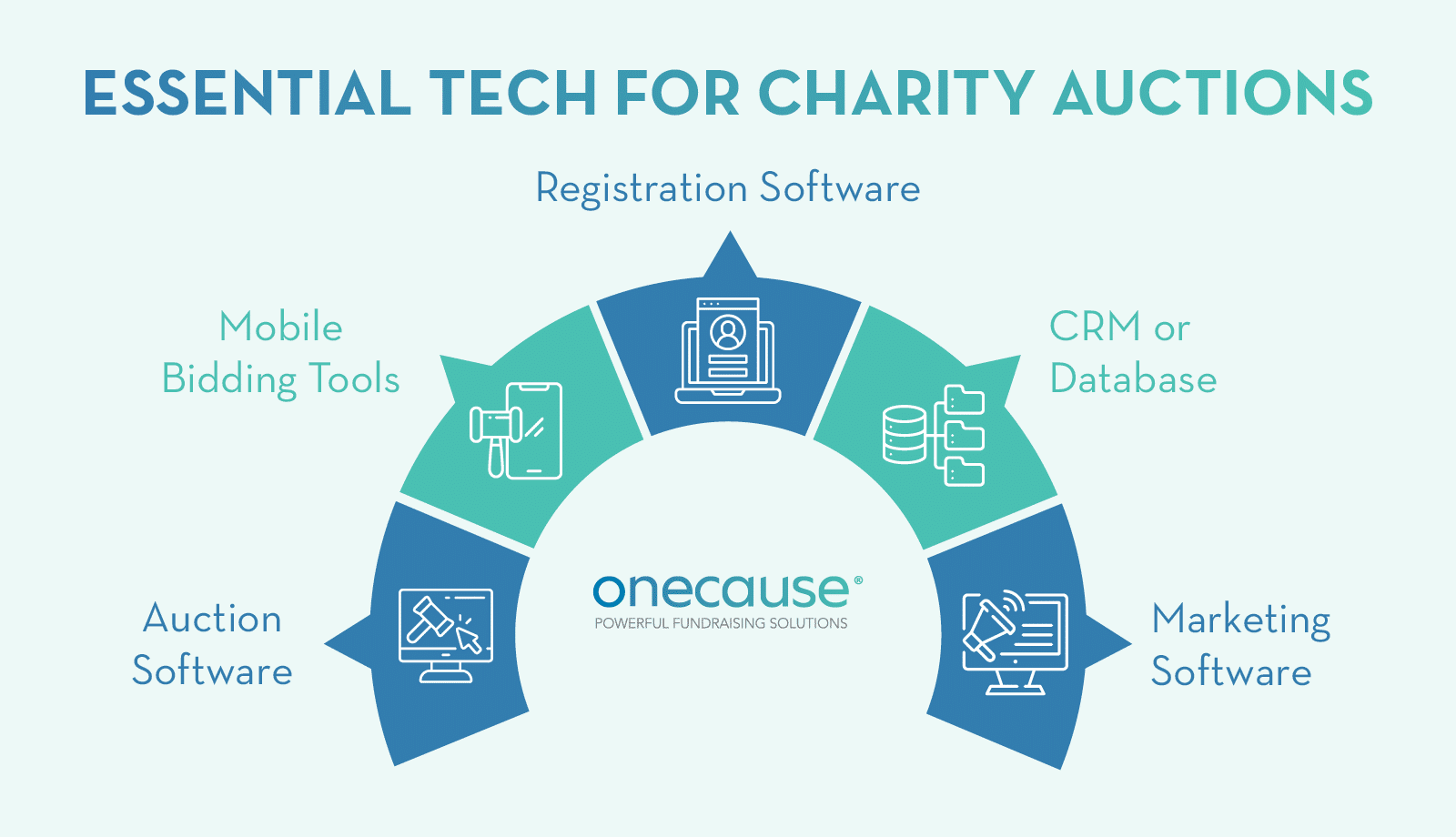
- Dedicated auction software to plan and manage your auction, from item tracking to seating chart creation.
- Mobile bidding tools to streamline the bidding process for both in-person and virtual attendees.
- Registration software to accept registrations and payment information in advance.
- An underlying CRM or database to provide procurement and guest list insights and to store all the data your auction generates.
- Marketing software, especially for social media and email, to help promote your auction to your audience.
Explore our complete buyer’s guide to charity auction software for a full run-down of essential features to look for. If you’re planning an online auction, you’ll also need to ensure that your auction software allows you to create and fully customize a microsite and item catalog for your virtual event.
In general, using dedicated auction software that includes features to support mobile bidding, registration, and marketing will be your best bet in the long-run. One that integrates with your CRM will be even better! There are a few major benefits to building out your charity auction toolkit, like:
- Streamlined planning. Centralizing your efforts makes the entire process faster and more organized.
- Wider reach. Digital marketing and mobile bidding help you reach wider audiences (and generate more bids).
- Simplified logistics. Avoid the headache of tracking items and bids manually in spreadsheets or confusing paper bid sheets.
- More engagement data. The more data your auction generates, the more effectively you can plan your next one.
- Improved bidder experience. A streamlined registration process, online item catalog, and bidding tools will leave a great impression on bidders.
- Increased revenue. Each of these benefits help you raise more with each auction you host.
Mobile bidding, in particular, can take any type of charity auction to the next level.
This software is essential for engaging virtual audiences, but it dramatically improves the donor experience at live and silent auctions, as well. Plus, mobile bidding tools make it easy to share important notifications immediately. You can highlight an item that needs more bids, announce upcoming bid closures, and call out big bidders to up the energy.
Streamlined bidding and increased engagement translate to more revenue for your auction!
How to Plan Charity Auctions
To plan a charity auction, there are several core steps you should follow:
- Determine which type of auction you want to host and form a planning team.
- Set guidelines for your event – date/timeframe, budget, and fundraising goals.
- Review your auction and event toolkit, making new additions as needed.
- Brainstorm items for your auction and begin the procurement process with your team.
- Set up a site and registration page for your auction and promote them to your audience.
- Plan the specifics for your event – the venue, food, item displays, checkout process, etc.
- Host your event and keep up the energy throughout its duration.
- Follow up with attendees to thank them and steward future support.
For a more thorough walkthrough of the planning process for a generic auction event, explore our complete auction planning guide.
Of course, the exact process you follow to plan your own charity auction will vary depending on a number of factors.
For online or virtual auctions, you won’t need to worry about venues and food, but you will need to focus extra attention on your event website, item catalog, and digital marketing. Develop additional strategies for keeping bidders engaged over a longer timeframe, like planning livestreamed elements.
For live auctions, you’ll need to hire an auctioneer to run the event and oversee the bidding process. You’ll also need to focus on developing a concrete schedule for your event to maintain high energy and provide a more seamless experience for guests. Monitors, projectors, and mobile bidding tools will improve these events, too.
For silent auctions, you’ll need to ensure that your event has a schedule with set open and closing times. Auction software can help simplify this process. During your planning period, you’ll also need to devote time to packaging and displaying your items well. How you arrange and present them can have a big impact on bids!
For any type of auction, you might also choose to position your event as the grand finale of a larger campaign or event, like an ambassador campaign or golf tournament. You’ll need to factor these additional tactics into your planning process from the start. Download our eBook on ambassador fundraising for a quick guide to help you get started with this strategy.
How to Market a Charity Auction
For your auction to succeed, you’ll need bidders! Marketing your charity auction will be essential for a few reasons. You can use your marketing channels to:
- Invite supporters to your auction
- Secure early registrations
- Promote your auction items
- Generate excitement and competition
Marketing is crucial for any type of auction, live, silent, or virtual. For online auctions, digital promotions are especially important to make up for the lack of in-person engagement and to reach wider audiences to drive more bids. We recommend taking a multichannel approach to marketing your auction. Here’s how it might work:
The main idea of a multichannel marketing campaign is to use each of your digital outlets to drive more traffic both to one another and to your target action—in this case, your auction’s registration page. Here are the typical outlets that you might use:
- Social media profiles. Promote your auction, highlight big-ticket items, and encourage engagement.
- Email. Sending invitations and announcements via email is the most direct way to reach your list of contacts, especially loyal supporters.
- Your auction item catalog. The online catalog of your auction’s items is a valuable resource to generate interest. Check out risk-free travel auction packages to really build excitement.
- Online ambassadors. If you’ve recruited volunteer ambassadors, they can help by spreading the word to their networks.
- Supporters’ social media. Encouraging your followers to share your social media posts is a highly effective way to expand your audience.
Then, promote your content between each of these outlets. For instance, if you’ve written a blog post explaining your auction’s goals, share it on social media. Ask your ambassadors to share sneak previews of your item catalog with their own audiences. Just remember to always include a direct link to your auction’s registration page.
Remember to set specific goals for your marketing efforts. How many registrations do you want to secure? How many of those should be new attendees, and how many will be retained supporters? Creating concrete goals and metrics will make it easier to check in on your progress leading up to the auction, and it’ll give you a solid foundation for promoting your next auction.
Consider creating engaging challenges and contests for online supporters, too! Set goals for your ambassadors, and recognize their achievements with awards or prizes during your event. For all of your registrants, you could ask them to share your social media posts or create their own content about your mission. Then, during your event, call-out your top participants or draw a random name to win a prize.
Strategies like these are generally referred to as gamification, and it can supercharge engagement with your event before it even begins!
Top Trends for Charity Auctions
Whether you’re planning your nonprofit’s first charity auction or you’re a longtime auction pro, staying on top of changing trends and preferences will go a long way to boost the success of your event. Let’s walk through a few trends to keep in mind:
1. Item catalogs should be more focused than ever.
It’s more important than ever that your item procurement strategies (including donation request letters) are focused and tailored to your specific audience. Many organizations have already begun shifting to a less-is-more strategy.
Avoid overwhelming bidders with a huge range of items or too many in one price range. By anchoring your catalog with one or two showstopper items, plus several mid-range and lower-range packages, it’s easier to make sure every item gets attention and bids.
Review your past donor engagement data to more effectively target your audience with the items you know will catch their eye (rather than casting a wider net that won’t necessarily generate a positive ROI)). Check out our procurement tips and item ideas for more information.
2. Emphasize multimedia elements and appeals.
Just as virtual events are becoming a new norm for nonprofits, more tech should be implemented into any live events you host in the future, as well. Mobile bidding tools are a great example that can boost engagement at any auction event.
Monitors to display items, incoming bids, and fundraising totals is another effective choice for in-person auctions.
Additionally, consider using your mobile bidding tools to make direct appeals during your live or silent auctions. With the “fund-a-need” technique, you explain your fundraising goal, bring the energy up to a fever pitch, and award a prize to whoever makes the last donation before the timer ends.
Explore our fund-a-need guide to learn more about this strategy and why it’s become so popular.
3. Stay aware of top-selling categories across sectors.
Stay on top of types of items that have been trending up or down in luxury, art, and collectible auction markets. This is especially relevant for larger nonprofits that host high-revenue live auctions.
Luxury watches, jewelry, antique dolls, and Asian art have been popular in recent years.
For smaller organizations, get creative to tap into these trends while still fitting your audience and budget. For example, a school might auction a vintage school t-shirt from the ’70s or ’80s to tap into a sense of history and personal connection with parents placing bids.
Maximizing Revenue at Your Charity Auction
When you invest time, energy, and resources into planning a live, silent, or virtual auction of any size, you have to take steps to ensure your event generates a positive return on investment.
Auctions can be extremely lucrative for nonprofits and engaging for donors. However, simply planning and promoting your event isn’t always enough to guarantee a strong ROI. Here are our top recommendations for maximizing revenue at your auction:
- Focus on smart procurement. As mentioned above, strong procurement strategies and focused item catalogs are crucial. Offering a selection of items that’s specifically tailored to your audience is the most surefire way to generate engagement, bids, and ultimately revenue.
- Use technology to drive more engagement. Mobile bidding, text-to-give, gamification techniques, and peer-to-peer fundraising are all effective ways to increase engagement by making it easier to give and generating more interest.
- Encourage early payment registration. When every attendee registers their payment information in advance, you greatly streamline the check-out process and reduce the need to follow up with bidders who won items.
- Recruit ambassadors. As discussed earlier, ambassador campaigns can be a great way to generate more revenue because they attract more registrants and give new donors a personal connection to your cause. Social proof is a powerful fundraising resource!
- Incorporate buy-it-now options or add-ons. Letting bidders buy an item outright (at 150-200% of their initial value) and offering add-ons like sign-up parties and raffle tickets is an easy way to raise more by simply giving guests additional options.
- Charge registration fees if appropriate. For larger live or silent auction events, charge a registration or ticketing fee. If your event includes entertainment and food, the extra cost won’t be a surprise to attendees. Online auctions typically don’t include registration fees.
- Build corporate partnerships. Sponsorships from local businesses and large corporations are invaluable for nonprofits. Provide sponsors with public recognition during your event and in your online materials in exchange for donated auction items or general funding for your event.
Generating Long-Term Value with Charity Auctions
Finally, after you’ve planned your charity auction, implemented the right tools, secured your items, attracted an audience, and hit your fundraising goals, you’re all done, right? Wrong!
Now, it’s time to actively steward and retain the support of donors and attendees for the long-run. Plus, you should always take the opportunity to study your performance for strengths, areas for improvement, and new opportunities.
Analyzing your performance and prioritizing retention is particularly important when it comes to online auctions and virtual events, which can help you reach much wider audiences than previously possible. If you don’t take steps to keep your organization and mission on the minds of those new attendees, they’re likely to forget about you.
Here are a few of our top strategies for generating more long-term value with your auction:
- Immediately thank attendees. Taking the first step of expressing your gratitude to every participant, including those who didn’t win any items, lays the essential groundwork for retaining their support. Ideally, your tech stack should be able to handle this process by automating emails to your attendees.
- Review your auction’s performance. Once your event is over, it’s time to see where your strategies did well and where they fell short. For instance, if many attendees didn’t place any bids, you may need to rethink your procurement or pricing strategies. Consider sending a survey to get direct feedback from your guests.
- Keep supporters in the loop. Set up a basic email campaign to ensure auction attendees remember your organization. Determine a goal for the campaign, like making a donation or registering for your next event, and use each message to funnel readers further towards completing that goal.
- Identify key participants. Who spent the most at your auction? Who placed the most bids? Who won your showstopper items? Which ambassador secured the most registrations? You’ll definitely want to retain their support for your next event. Personally reach out to individuals like these to express your gratitude.
- Conduct wealth screening. For high-revenue events, it’s a good idea to screen your list of attendees for additional major fundraising opportunities. One of your auction guests might have both the ability and the inclination to make a more sizable gift to your organization, but you must actively identify them and pursue their support.
Charity Auctions with OneCause
Powerful events need powerful fundraising software! The OneCause Fundraising Platform makes giving modern, flexible, and seamless to drive deeper engagement and grow your fundraising. Explore our versatile, all-in-one fundraising software that meets the expectations of today’s donors, supporting any event—including online, virtual, live, and silent auctions.
Taking Your Charity Auction to the Next Level
With charity auctions, you can offer your supporters an engaging experience that generates lots of revenue for your nonprofit while laying the foundation for strong donor relationships. With a robust fundraising platform on your side, like OneCause, you’ll tackle your tasks efficiently and host your best event yet.
Want to learn more about taking your charity auctions to the next level? Check out these resources:
- How to Run a Silent Auction: The Step-by-Step Guide. Silent auctions are a great option for nonprofits that don’t want to deal with a hectic live auction. Discover how to run your own silent auction.
- Online Charity Auctions Guide & 13 Best Auction Providers. Interested in taking your auction online? Learn everything you need to know, including top providers, here.
- 20 Premier Silent Auction Software Solutions to Grow Revenue. Ready to purchase silent auction software? Explore our top recommendations in this guide.





